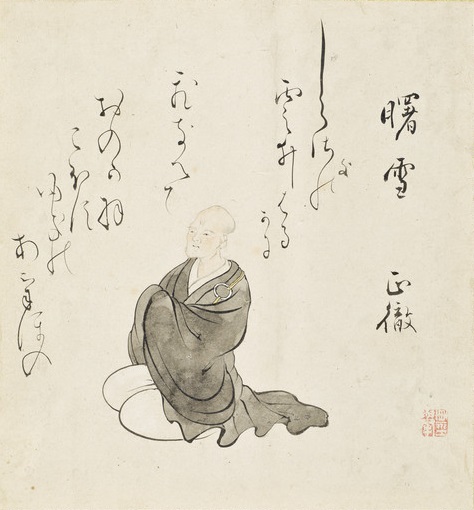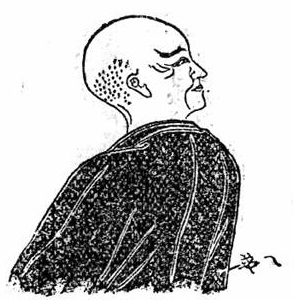ZEN MESTEREK ZEN MASTERS
« Zen főoldal
« vissza a Terebess Online nyitólapjára
清巌正徹 Seigan Shōtetsu (1381-1459)

Portrait from the album Selection of Thirty-six Poets Beyond the Anthologies
by 酒井抱一 Sakai Hōitsu (1761-1829)
ink and color on paper, 21.59 x 20.32 cm
LACMA (Los Angeles County Museum of Art)
https://en.wikipedia.org/wiki/Sh%C5%8Dtetsu

Portrait of Shōtetsu (Teikoku Jinmei Jiten, p. 1629.)
Unforgotten Dreams
Poems by the Zen Monk Shōtetsu
Edited and translated by Steven D. Carter
Columbia University Press, 1997
https://www.gwern.net/docs/japanese/1997-carter-shotetsu-unforgottendreams.pdf
Voice of violent age : a contextual reading of Shōtetsu's poetry in Shōtetsu Monogatari
by
Penelope Anne Shino
Thesis (PhD--Japanese)--University of Auckland, 2005
This work comprises an in-depth study ofwaka poetry by Muromachi poet-monk Shotetsu (1381-
1459) included in his poetic treatise Shotetsu Monogatari (ca. 1448). His compositions are
appreciated in the context of his own life experience and the external environment in which he
lived, with particular emphasis placed on understanding and attempting to resolve the apparent
paradox existing between Shotetsu's detached, rarified, highly aesthetic poetry and the turbulent
age in which he lived, a contradiction which appears to challenge the prevalent theory of the
essential contextuality of all literature.
Chapters describing Shotetsu's life and the historical, political, social, cultural and spiritual currents
of his era constitute the first part of this dissertation, providing a detailed picture of the 'context'.
The second part of the dissertation is dedicated to an analysis of Shotetsu' s poetry as described
above. An overview of Shotetsu' s poetry is provided, in which we attempt to explain the thematic
and imagistic range of his poetry in terms of the poet's simultaneous exercise of both conservatism
and innovation. The role ofyugen ('mystery and depth') and its interchangeability withyoen
(,ethereal beauty') in Shotetsu's poetic is singled out for particular discussion in view of its
paramount importance to Shotetsu. A detailed annotated translation with interpretation of all poetry
by Shotetsu contained in Shotetsu Monogatari follows. The dissertation concludes with an
evaluation in which we determine the extent to which we believe a contextual interpretation can be
applied to Shotetsu's poetry.
"Retrospection and anticipation: an analysis of Shōtetsu's yūgen"
by Penelope Shino
New Zealand Journal of Asian Studies 16, 1 (June 2014): 1-22
https://web.archive.org/web/20170406020122/http://nzasia.org.nz/journal/jas_jun2014_shino.pdf
Exploring Nagusamegusa (1418): the Semiotics of Encounter and Exchange for a Poet-traveller in Muromachi Japan
by
Penelope A Shino
IAFOR Journal of Arts & Humanities, 1(1). Summer 2012
The paper examines aspects of exchange and encounter informing a fifteenth century Japanese travelogue Nagusamegusa (‘Grasses of Consolation', 1418), written by the influential poet and Zen priest Shōtetsu (1381-1459) in the context of social and cultural transformations taking place in Japan in the mid-Muromachi era.